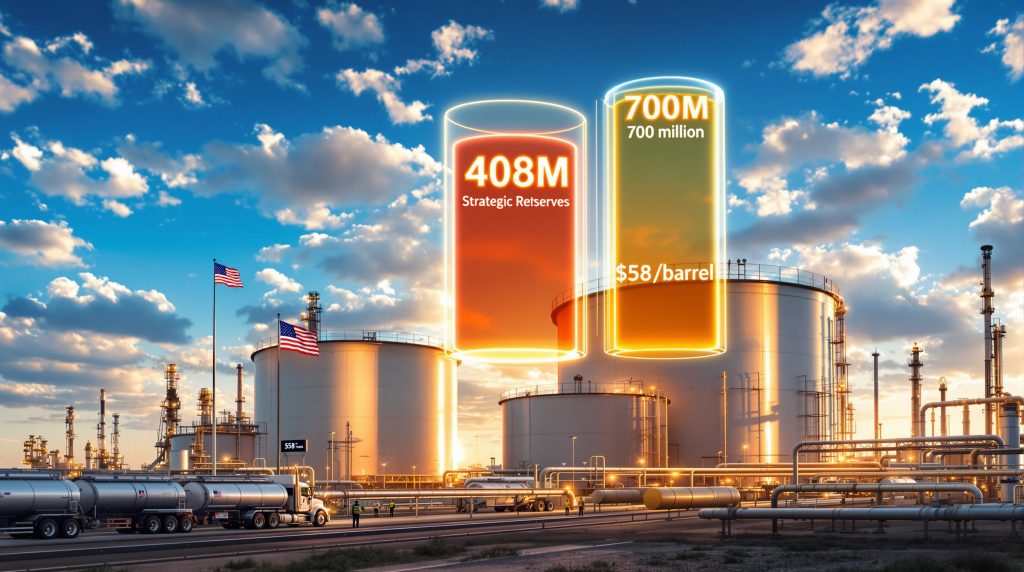Why Strategic Reserve Refilling Represents More Than Token Politics
The United States has initiated a modest but symbolically significant crude oil purchase program, marking the first steps toward rebuilding the Strategic Petroleum Reserve after years of substantial depletion. This U.S. Buys a Token Barrel to Refill the Strategic Reserve initiative signals a fundamental shift in energy policy priorities, moving away from emergency releases toward strategic stockpiling for long-term national security.
Current market conditions present an opportunistic environment for strategic petroleum acquisitions, with crude prices experiencing notable declines from earlier peaks. The timing reflects careful consideration of both budgetary constraints and market dynamics that favor government purchasing programs.
Current Strategic Reserve Holdings Create Restoration Challenge
The Strategic Petroleum Reserve currently maintains significantly reduced inventory levels compared to historical capacities. After major releases during 2022 to address gasoline price pressures following global energy market disruptions, the reserve requires substantial replenishment to restore optimal strategic capacity.
This depletion occurred when previous administrations authorized large-scale releases totaling over 180 million barrels, representing the most extensive coordinated emergency release in the reserve's operational history. The drawdown addressed immediate market pressures but created long-term strategic vulnerabilities requiring systematic restoration efforts.
Historical Emergency Response Precedents
The SPR has served crucial roles during multiple energy crises throughout its operational history. Notable deployments included responses during the 1991 Gulf War conflict, Hurricane Katrina's infrastructure damage in 2005, and supply disruptions during the 2011 Libyan civil war. Each release demonstrated the reserve's value as a strategic buffer against supply interruptions.
These historical precedents underscore the importance of maintaining adequate reserve levels to address future emergencies, whether caused by geopolitical conflicts, natural disasters, or unexpected market volatility that could threaten energy security.
Initial Purchase Program Details Reveal Strategic Approach
The Trump administration has authorized crude oil acquisitions totaling 1 million barrels, with delivery scheduled between December 2025 and January 2026. This procurement utilises $171 million in allocated funding from recent legislative appropriations, representing the first significant SPR purchasing since major drawdowns occurred three years ago.
Purchase Program Specifications:
- Volume: 1 million barrels of domestic crude oil
- Funding: $171 million budget allocation
- Average Cost: Approximately $58 per barrel
- Delivery Schedule: December 2025 through January 2026
- Storage Facilities: Bayou Choctaw (Louisiana) and Bryan Mound (Texas) locations
Economic Timing Advantages
Current crude oil pricing presents favourable acquisition conditions, with prices declining roughly 30% from early 2025 peaks. This reduction stems from global oversupply dynamics and record-setting domestic production levels, creating advantageous cost structures for strategic stockpiling initiatives.
Energy market analysts note that such pricing windows may not persist indefinitely, making opportunistic government purchases strategically valuable for long-term reserve building. The current budget allocation could theoretically support acquisition of up to 3 million barrels at prevailing market rates.
Full Reserve Restoration Requires Substantial Long-Term Investment
Comprehensive SPR restoration to full operational capacity would necessitate purchasing approximately 292 million additional barrels beyond current holdings. At today's market pricing, this complete restoration would require an estimated $17 billion investment, highlighting why current purchases represent initial steps rather than comprehensive refilling.
Restoration Challenge Factors:
- Financial Requirements: Multi-billion dollar investment needs
- Infrastructure Constraints: Storage facility maintenance and capacity limitations
- Market Impact Considerations: Large purchases could influence global oil pricing
- Timeline Realities: Full restoration requiring several years of sustained procurement
Budget Allocation Limitations
The current $171 million funding allocation, while sufficient for initial 1-million-barrel purchases, represents a modest fraction of comprehensive restoration requirements. This budget constraint explains the graduated approach to rebuilding strategic reserves through incremental procurement programs.
Congressional appropriations processes will likely determine the pace and scope of future SPR restoration efforts, with energy security priorities competing against other federal spending requirements for limited budgetary resources.
National Security Implications Drive Strategic Priorities
Energy security considerations have elevated SPR restoration as a critical national defence priority. The reserve serves as essential infrastructure for maintaining energy resilience capabilities during supply disruptions, whether caused by geopolitics and oil prices factors, natural disasters, or market volatility.
Current global energy dynamics underscore the strategic value of robust petroleum reserves. Recent geopolitical upheavals and supply chain vulnerabilities have reinforced the importance of domestic energy security infrastructure capable of responding to unexpected emergencies.
Bipartisan Strategic Support
Strategic petroleum reserves maintain broad bipartisan support as essential national security infrastructure. The current purchasing initiative demonstrates sustained commitment to energy security preparedness across different political administrations, reflecting consensus on strategic energy priorities.
This bipartisan backing provides stability for long-term restoration planning, even as political transitions may influence specific implementation approaches or funding levels for reserve building programs.
Market Conditions Influence Strategic Refilling Approaches
Record domestic crude oil production levels provide strategic advantages for SPR refilling initiatives. Current production capacity offers opportunities to source domestic crude while supporting American energy producers, reducing dependence on international suppliers and strengthening energy infrastructure resilience.
McKinsey's Global Energy Perspective 2025 projects that oil, gas, and coal will represent between 41% and 55% of global energy use in 2050, suggesting sustained demand for petroleum products despite energy transition efforts. This projection supports arguments for maintaining robust strategic reserves as long-term energy security assets.
Global Supply-Demand Dynamics
Current global oversupply conditions, driven by increased production from multiple sources and moderate demand growth, create favourable environments for strategic stockpiling initiatives. Saudi Aramco CEO Amin Nasser has emphasised that the oil industry must increase exploration and investment in new supply to avoid future shortages.
Nasser noted at the 2025 Energy Intelligence Forum that "resilient demand and pressing needs for long-term supply investments are now widely accepted industry priorities". He observed that the energy transition faces reality checks, with energy security and reliability concerns often superseding sustainability priorities amid geopolitical uncertainties.
Long-Term Restoration Projections Require Sustained Commitment
Industry analysts project comprehensive SPR restoration will require sustained purchasing programs spanning multiple years. The restoration process involves careful market timing to minimise price disruption while steadily rebuilding strategic reserves through graduated procurement phases.
Projected Restoration Timeline:
- Phase 1: Initial purchases (current 1-million-barrel acquisition)
- Phase 2: Expanded procurement programs pending additional Congressional funding
- Phase 3: Sustained purchasing to achieve target capacity levels
- Phase 4: Maintenance purchasing to offset future emergency releases
Infrastructure Modernisation Requirements
SPR storage facilities require ongoing maintenance and modernisation to ensure operational readiness for both storage and distribution capabilities. Some storage caverns have experienced maintenance delays that could potentially constrain refilling rates regardless of funding availability.
Facility upgrades and maintenance programs represent additional costs beyond crude oil acquisition expenses, requiring comprehensive budget planning for successful reserve restoration and long-term operational sustainability.
Energy Policy Shifts Reflect Evolving Strategic Priorities
The decision to restart SPR purchasing reflects broader energy policy emphasis on security and strategic preparedness over short-term price relief measures. This approach contrasts with previous policies that prioritised immediate gasoline price reduction through reserve releases.
McKinsey's recent analysis indicates that energy affordability and security concerns now often outweigh climate goals in shaping policy and investment decisions. Their research found that geopolitical uncertainty, shifting policies, and increasing power demand are reshaping global energy landscapes, with cost competitiveness remaining paramount for widespread technology adoption.
Pragmatic Energy Transition Considerations
Current energy policy approaches reflect recognition that energy transitions require sustained affordability and reliability alongside sustainability objectives. McKinsey noted that crucial alternative fuels may not achieve broad adoption before 2040 unless mandated, due to competitiveness challenges with traditional energy sources.
These realities support arguments for maintaining robust petroleum reserves as transitional energy security assets, providing stability during potentially lengthy periods of energy system evolution and technological development.
Market Impact Assessment of Sustained Refilling Programs
Sustained SPR purchasing could provide underlying support for crude oil prices, particularly during periods of market weakness. Furthermore, government purchases represent consistent demand that may help stabilise producer revenues and encourage continued domestic production investment.
Regular procurement programs support domestic crude oil supply chains by providing predictable government demand. This stability encourages continued exploration and production investment, strengthening overall energy security through enhanced domestic production capabilities.
Price Impact Considerations
Individual purchases of 1-3 million barrels generate minimal direct impact on gasoline prices for consumers. However, sustained large-scale purchasing programs could provide modest upward price pressure over extended timeframes, balancing market support against consumer cost considerations.
Strategic timing of government purchases considers multiple factors including oil price stagnation factors, budget availability, storage facility readiness, and broader energy market conditions to maximise strategic value while minimising market disruption.
Strategic Reserve Management Questions and Considerations
How long might complete SPR restoration require?
Complete restoration to full capacity could require 5-10 years of sustained purchasing, depending heavily on annual Congressional budget allocations and global oil price trends. The timeline depends significantly on political support for continued funding appropriations.
What determines optimal SPR purchase timing?
Purchase timing considerations include crude oil price levels, budget availability, storage facility readiness, market conditions, and geopolitical factors. Consequently, the objective involves maximising strategic value while minimising market disruption and optimising cost-effectiveness.
How do SPR purchases affect domestic energy markets?
Government crude oil purchases provide demand support for domestic producers while having minimal immediate impact on consumer gasoline prices. For instance, sustained programs may provide modest long-term price support that encourages continued production investment.
Beginning Strategic Energy Security Restoration
The current 1-million-barrel purchase represents significantly more strategic importance than its modest volume might suggest. This initial procurement demonstrates renewed commitment to energy security preparedness while establishing operational procedures for larger future acquisitions when additional funding becomes available.
This symbolic beginning of strategic reserve restoration occurs amid evolving global energy dynamics and persistent geopolitical uncertainties that underscore the critical importance of maintaining robust emergency petroleum stockpiles for national security purposes. Additionally, analysts examining oil price rally analysis suggest that current market conditions present optimal acquisition opportunities.
As energy markets continue evolving and international security challenges persist, strategic petroleum reserves become increasingly vital infrastructure for maintaining economic stability and energy security preparedness. The current U.S. Buys a Token Barrel to Refill the Strategic Reserve initiative marks the initial phase of what may develop into comprehensive multi-year efforts to restore America's strategic energy emergency response capabilities.
In conclusion, this modest beginning addresses concerns highlighted by those studying oil price trade war implications and oil price crash insights. However, the refilling efforts represent just the beginning of a comprehensive restoration strategy necessary for long-term energy security.
Disclaimer: This analysis involves projections and strategic assessments based on current market conditions and policy directions that may change due to political, economic, or geopolitical developments. Energy market forecasts and government policy implementations carry inherent uncertainties that could affect actual outcomes.
Ready to Capitalise on Energy Market Opportunities?
Discovery Alert's proprietary Discovery IQ model delivers real-time alerts on significant ASX mineral discoveries, helping subscribers identify actionable opportunities across energy commodities and resources sectors before broader market recognition. Visit Discovery Alert's dedicated discoveries page to explore historic examples of major mineral discoveries that generated substantial returns, then begin your 30-day free trial today to position yourself ahead of evolving energy and commodities markets.




